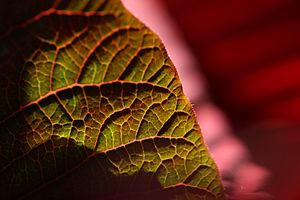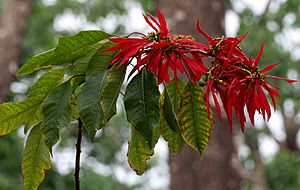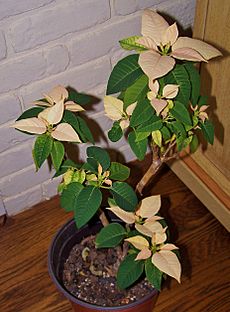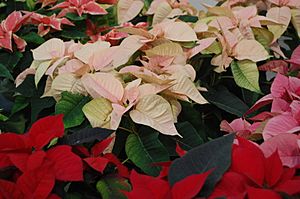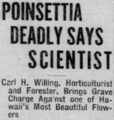Poinsettia facts for kids
Quick facts for kids Poinsettia |
|
|---|---|
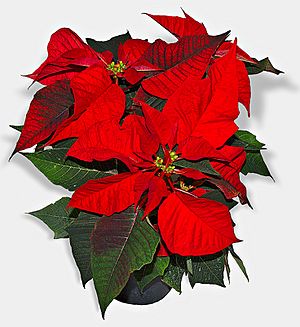 |
|
| Scientific classification | |
| Genus: |
Euphorbia
|
| Species: |
pulcherrima
|
The poinsettia (Euphorbia pulcherrima) is a very popular plant. It is also known as the Christmas Flower. This plant belongs to the diverse spurge family, called Euphorbiaceae. Poinsettias originally come from Mexico. They are famous for their bright red and green leaves. Many people use them as decorations during Christmas. The plant got its common English name from Joel Roberts Poinsett. He was the first United States Minister to Mexico. He brought the plant to the U.S. in 1825.
Contents
What Does a Poinsettia Look Like?
The poinsettia is a shrub or a small tree. It usually grows to be about 0.6 to 4 meters (2 to 13 feet) tall. The plant has dark green leaves. These leaves have jagged edges and are about 7 to 16 centimeters (3 to 6 inches) long.
The bright colored parts of the poinsettia are called bracts. People often think these bracts are flower petals. This is because they are grouped together and are very colorful. However, they are actually special leaves. Bracts are usually flaming red. But they can also be orange, pale green, cream, pink, white, or even marbled.
The colors of the bracts change because of something called photoperiodism. This means they need darkness to change color. They need about 12 hours of darkness at a time for at least five days in a row. At the same time, the plants need lots of light during the day. This helps them get the brightest colors.
The actual flowers of the poinsettia are quite small and plain. They do not attract insects that help with pollination. These tiny flowers are found in small yellow structures. These structures are in the center of each leaf bunch. They are called cyathia.
Where Do Poinsettias Grow Naturally?
Poinsettias are native to Mexico. You can find them growing in the wild in tropical forests. These forests are found at medium heights above sea level. They stretch from southern Sinaloa all the way down the Pacific coast of Mexico to Chiapas and Guatemala. They also grow inland in hot, dry forests. These areas include Guerrero, Oaxaca, and Chiapas.
Poinsettias in History and Traditions
The Aztec people used the poinsettia plant for many things. They used it to make a red dye. They also used it as a medicine to reduce fever. In Nahuatl, the language of the Aztecs, the plant is called Cuetlaxochitl. This means "flower that grows in residues or soil."
Today, in Mexico and Guatemala, it is known as Flor de Nochebuena. This means "Christmas Eve Flower." In Spain, it is called Flor de Pascua or Pascua, meaning Easter flower. In Chile and Peru, the plant is known as "Crown of the Andes."
The poinsettia became linked with Christmas in the 16th century. A legend tells of a poor girl named Pepita or Maria. She had no gift for Jesus' birthday celebration. An angel told her to gather weeds from the roadside. She placed them in front of the church altar. Crimson blossoms then grew from the weeds. These became poinsettias.
From the 17th century, Franciscan friars in Mexico used poinsettias in their Christmas celebrations. The star-shaped pattern of the leaves is said to represent the Star of Bethlehem. The red color is thought to symbolize the blood sacrifice of Jesus through the crucifixion of Jesus.
Poinsettias are very popular Christmas decorations. You can see them in homes, churches, and offices across North America. They are easy to find in many stores. In the United States, December 12 is celebrated as National Poinsettia Day.
How the Poinsettia Industry Grew in America
Albert Ecke moved from Germany to Los Angeles in 1900. He started a dairy and orchard in the Eagle Rock area. He became very interested in poinsettias. He started selling them from street stands.
His son, Paul Ecke, found a special way to grow the plants. But it was Paul Ecke Jr., the grandson, who made poinsettias famous for Christmas. He changed how the plants were sold. Instead of shipping mature plants by train, he sent plant cuttings by air.
He also sent free plants to TV stations. They would display them on air from Thanksgiving to Christmas. Paul Ecke Jr. even appeared on TV shows like The Tonight Show and Bob Hope's Christmas specials. This helped promote the plants even more.
Until the 1990s, the Ecke family had a big advantage in selling poinsettias. They had moved their business to Encinitas, California, in 1923. Their secret was a technique that made their plants look much better. They would graft two types of poinsettia together. This made the plant fuller and more compact. A poinsettia left to grow on its own can look a bit wild. The Eckes' method made every seedling branch out. This resulted in a bushier plant.
In the late 1980s, a university researcher named John Dole discovered the Eckes' secret method. He published his findings. This allowed other growers to start growing similar plants. Many of these new growers used cheaper labor in Latin America. The Ecke family's business, now led by Paul Ecke III, decided to stop growing plants in the U.S. However, as of 2008, they still supplied about 70 percent of the U.S. market. They also supplied 50 percent of the worldwide market.
Growing Poinsettias
Poinsettias have been grown in Egypt since the 1860s. They were brought there from Mexico. In Egypt, they are called bent el consul, which means "the consul's daughter." This name refers to the U.S. ambassador, Joel Poinsett.
There are over 100 different types of poinsettias that people grow today.
Outside of their natural home, poinsettias are usually grown indoors. They like good morning sun. Then they prefer shade during the hottest part of the day. Many people think poinsettias cannot be kept outside in winter. But they can, as long as they are protected from frost. Poinsettias are widely grown and very popular in warm climates. These include places like Australia, Rwanda, and Malta. In the mid-hills of Nepal, they are called Lalupate (लालुपाते). This means "plant with red leaves" in Nepali.
To get the colored bracts, the plant needs a daily period of long, dark nights. This should be followed by bright, sunny days. This process needs to happen for about two months in the autumn. Even a little bit of light during these dark nights can stop the bracts from changing color. This light could come from a TV, under a door, or even from passing cars or street lights. For commercial growing, poinsettias are placed in a greenhouse. The greenhouse is then completely covered to create the necessary darkness.
To make plants with many flowers, growers sometimes use a special method. They use a type of infection called a phytoplasma infection. This infection makes the plant grow more side branches, which means more flowers. Ing-Ming Lee of the USDA Agricultural Research Service discovered how phytoplasmas help with this.
Images for kids
See also
 In Spanish: Flor de pascua para niños
In Spanish: Flor de pascua para niños


